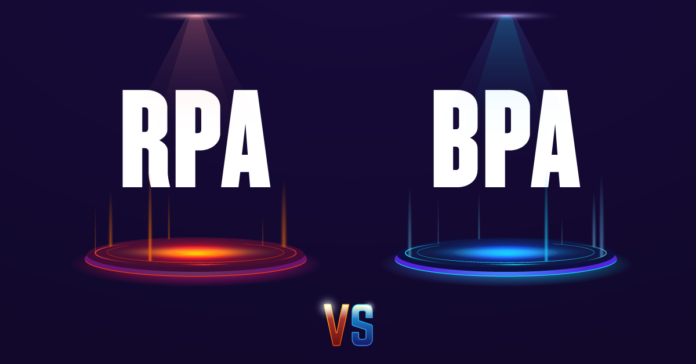Robotic Process Automation solves problems at the task level. Business Process Automation solves problems at the workflow or process level.
Industries are looking forward to various emerging process transformation and automation technologies. Acronyms like BPA, RPA, AI, MI, are gaining immense popularity in the software industry. The meaning of BPA is Business Process Automation, and that of RPA is Robotics Process Automation and are essential tech tools used to increase the productivity and efficiency of businesses. According to the Global Newswire, “An increased demand for business process automation (BPA) is expected to be the main growth driver through the use of Artificial Intelligence (AI) and software robotics.” Modern enterprises essentially need to switch to Robotic Process Automation (RPA) for faster deployment, scaling, execution, as it is expected to develop and grow at the highest growth rate in the coming years. IT executives, globally, prioritize on digital transformation, focussing on various Business Process Automation tools and Robotic Process Automation tools to expedite their revenue growth. Adoption of Cloud-based solutions, and Artificial Intelligence, for increasing the internal efficiency of any organization or SMEs are paving new scope of opportunities for using RPA, across diverse industry verticals.
Both RPA and BPA, contribute by streamlining the business processes and increasing the revenue, with distinct roles to play in the digital transformation of an organization. Both are used in collaboration with each other to pursue significant savings, improve efficiency, and add value to your business. Let us have a look at both of them in detail.
RPA or Robotic Process Automation
According to Gartner, the Robotic Process Automation (RPA) software had high demand, with revenue growing 63.1% in 2018 to $846 million, and $1.3 billion in 2019. A recent report by Research and Market says that “The robotic process automation market was valued at USD 1549.6 million in 2019 and is expected to reach USD 7109.3 million by 2025, at a CAGR of 27.7% over the forecast period 2020 – 2025.” This advanced technology is used to replace the repetitive efforts of humans to perform a task and perform it in an automated way. Wastage of human time and skills in achieving the same low-value tasks results in wastage of resources. RPA helps in increasing the efficiency and productivity by automating the human task, with the help of a robot or a machine, to get the desired output, without human involvement. RPA has gained immense reputation over the years and is in high demand due to its promising advantages in all the industry domains.
RPA is also known as Smart Automation or Intelligent Automation as it is programmed to perform a series of tasks, without any human intervention. Different functions, like communicating with various processes and systems, manipulation of data, triggering responses, etc., can be easily handled using robotic process automation. QA testers and engineers in the software industry, like SAP, Microsoft Dynamics 365, and Salesforce, are using RPA testing as a powerful tool for data test and Regression Testing. RPA automation testing tools support codeless automation macros on the desktop and can do some useful things.
Procurement Automation, Lifecycle management, Workload management, Credential management, SLA-based Automation, and Citrix management are looking forward to using RPA to enhance their business application in new industry domains and cater to higher operational and security capabilities. As a tactical tool, other practical examples of RPA include the following:
- Payroll Processing
- Automated Email Review and Reply
- Call Center Routing
- Form Generation
- Data Transfer between Systems.
- Vendor Onboarding
- Customer Order Processing
BPA or Business Process Automation
It is a more strategic approach, where an overall framework for an organization is generated for improvement of processes. BPA is an extension of BPM, i.e., Business Process Management, which is used to examine, analyze, and streamline business systems. It helps in overall decision making, improving efficiency and productivity, with cost-reduction and enhanced value of the end product. Business Process Automation has some essential characteristics, and they are as follows:
- Strategic and Deep Analysis of Existing Processes
- Comprehensive Transformation
- Strategic Planning
- Purpose-Built Technological Solutions
- Holistic/Macro-Level Improvements
Combined benefits of RPA and BPA
Business Process Automation serves as a bigger picture, which encapsulates the Robotic Process Automation to develop a comprehensive plan for the improvement of core processes, affecting the entire business workflow. With optimal performance, cost-effectiveness, and safety, BPA chains together the tasks of RPA, into a single strategy to empower core business improvements. RPA serves specific requirements, whereas BPA guides to help your business gain both strategic and tactical benefits from automation.
RPA helps in automating specific tasks, like, receiving verification, verification of Invoice, purchase order creation and approval, invoice approval, review of vendor compliance, and performance, using specific software tools.
BPA’s main aim is to specify the goals and provide guidance for business growth. Considering a Business Process Automation example, where the purpose is P2P automation, BPA includes strategies for evaluating and improving the existing P2P workflows. Analyzing workflows and selecting them for automation, deciding tools for automation, implementing the plan, and finally reviewing the results, while making further refinements, all is done under BPA. Whereas RPA provides process-specific benefits like eliminating rogue spend and fraud, access to shared data resources through cloud, or mobile, improved staff efficiency due to automation of repetitive, low-value tasks, faster and accurate invoice processing, and many more.
Considering the business benefits of RPA and BPA, organizations are implementing digital transformation strategies to automate workflow and gain business advantage, globally. By shifting from manual to a cloud-based platform, with increased efficiency and productivity, business leaders can empower their processes and human resources, and achieve high business gains.








![Avast Driver Updater Key 2022 | Activation Key V2.5.9 [Free]- Avast Driver Updater Key 2021](https://vintank.com/wp-content/uploads/2021/02/Avast-Driver-Updater-Key-2021-100x70.jpg)
![Avast Premier Activation Code and License Key [Working] Avast Premier Activation Code and License Key](https://vintank.com/wp-content/uploads/2021/09/Avast-Premier-Activation-Code-and-License-Key-100x70.jpg)
